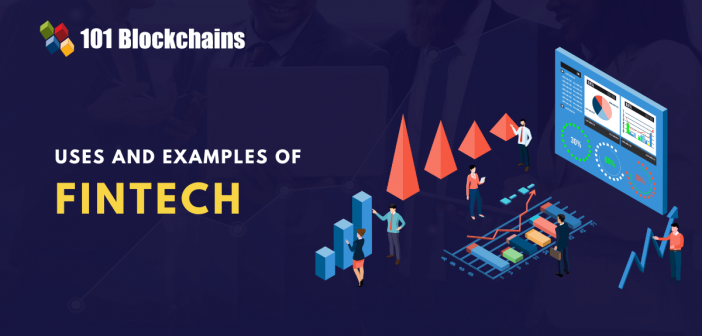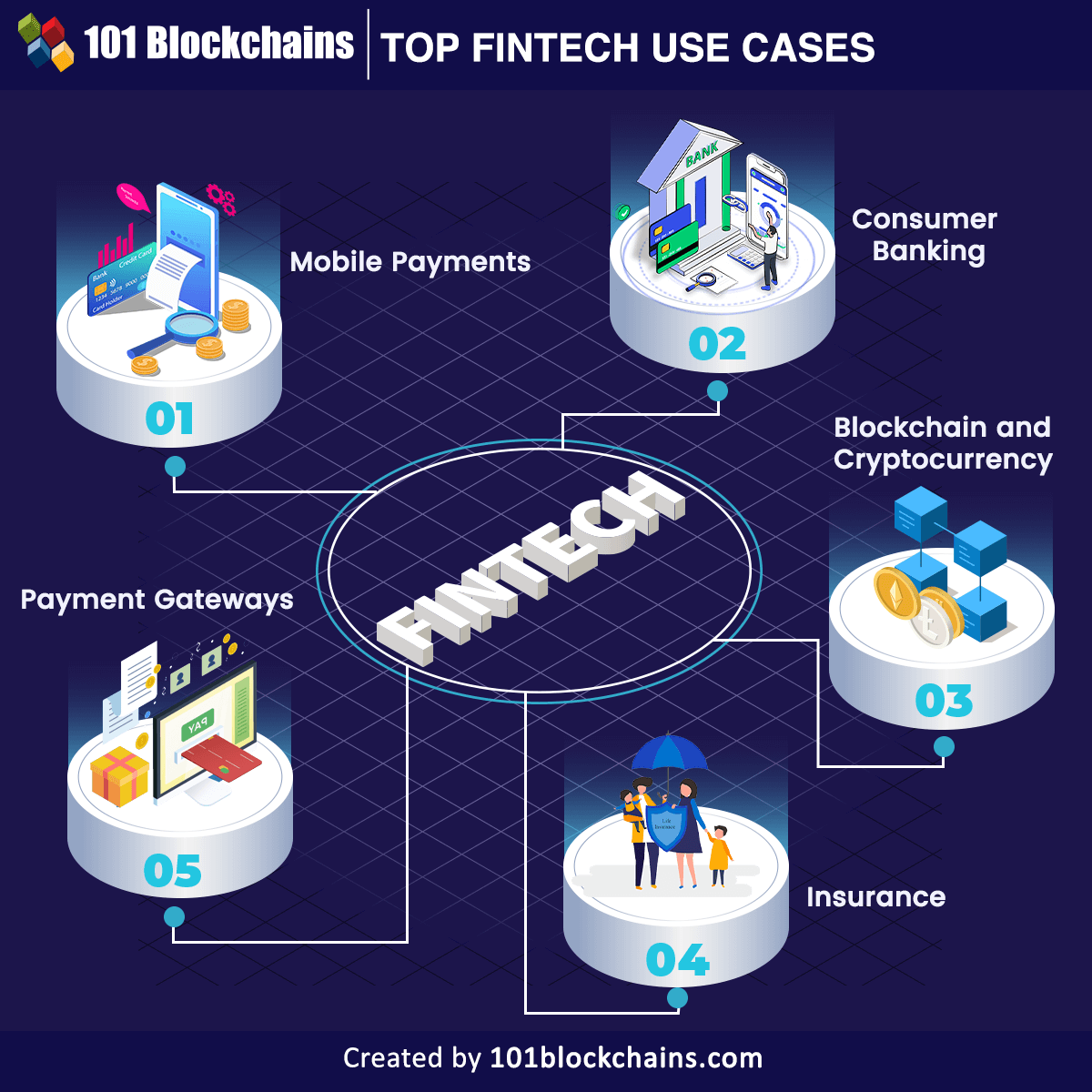Learn how blockchain truly works, master key definitions, and uncover what makes smart contracts so "smart." Dive into the fundamentals, gain valuable insights, and start your blockchain journey today!

- FinTech
James Howell
- on December 19, 2022
Financial Technology (FinTech) – Uses and Examples
Financial services have been through many promising advancements in recent times. Digital banking, cryptocurrencies, and, most important of all, digital lending have changed the traditional viewpoint on fintech. While the common fintech examples and types prove the potential of financial technology, it is important to learn about its uses and examples. The combination of finance and technology has evolved as a popular blanket term with multiple meanings.
However, it points to the development of a new industry that relies on technology to streamline the experience of traditional financial services. At the same time, the general assumption about fintech draws references to blockchain and algorithm-based trading. On the other hand, you could also find everyday applications in the field of fintech. For example, mobile banking or online loan apps are prominent examples of fintech we use in our daily lives.
What are the other examples of fintech you should know about? A detailed awareness of fintech use cases could help you understand the potential of fintech and how it could help you. The following post points out some of the popular uses and examples of financial technology in action.
Excited to explore the impact of technology on financial services? Enroll Now in the Certified Fintech Expert (CFTE)™ Certification Course Now!
Brief Overview of Fintech
Before you reflect on the popular fintech examples, it is important to develop a basic understanding of fintech. The simplest definition of fintech describes it as any technology which helps businesses and consumers have a better experience of financial services. It refers to any organization or service which facilitates banking and financial services by using software applications or any other technology. The beginning of fintech has been marked by the arrival of early credit cards and ATMs. Since then, fintech has been gradually imposing a disruptive impact on various aspects of the world of financial services.
At a particular point in time, fintech only referred to back office operations in financial institutions such as stock trading companies and banks. The introduction of new fintech examples in banking gained momentum with the arrival of the internet and the rise of mobile computing. Users and businesses could now rely on a consistently expanding array of formidable technology tools that could support personal and commercial finance. How is fintech relevant for the future of financial services? The answer is evident in the need for establishing a cashless society, based on the staggering growth in the impact of technology on the financial world.
Learn the basic and advanced concepts of Fintech. Enroll Now in Fintech Fundamentals Course!
Goals of Fintech
The objectives underlying the foundations of fintech could offer a credible impression of gradually expanding integration among financial services and digital technologies. Fintech could enable better and automated delivery of financial services for businesses and consumers. Most important of all, fintech examples showcase how it emphasizes companies delivering innovative financial services and solutions.
What does fintech aim to achieve? The basic goal of fintech deals with supporting different companies and consumers in the effective management of financial transactions. Now, financial transactions are no longer restricted to laptops and desktops as fintech enables users to access desired financial services from their smartphones.
The substantial growth in funding for fintech every year has proved that fintech is gradually becoming stronger and more capable of achieving your goals. Fintech-enabled tools have served many viable improvements in the approaches for tracking, managing, and accessing financial services. As a matter of fact, around 64% of millennials in the US have one comprehensive banking app with multiple financial services on their phone. How is fintech useful for different types of financial service users?
You might also be interested in How to Become a Fintech Expert?
Top Fintech Use Cases

The discussion on the usefulness of fintech for different types of users would obviously draw the limelight on the use cases of fintech. The impact of fintech has been evident in the way it caused disruption of conventional banking and financial services. The multiple fintech use cases have emerged as prominent threats to the traditional, brick-and-mortar institutions for financial services. As of now, millions of users rely on fintech in some form or the other, generally through smartphones and mobile devices.
Most important of all, fintech has also developed as a productive solution to the problems of access to banking and financial services. From what we know, fintech could open the doors to financial services for almost 2 billion unbanked people in the world. The fintech examples would help you understand how it can improve the accessibility of financial services without relying on traditional banks and other financial institutions. Here are some of the notable uses of fintech, along with the relevant examples for each use case.
-
Mobile Payments
The most noticeable answers to “what are examples of fintech?” would focus on the potential for mobile payment transactions. More than 5.11 billion mobile users all over the world could tap into the mobile payments market with innovative applications of fintech. Experts have predicted that the mobile payments market may grow by more than $4.3 trillion by 2023.
At the same time, the integration of financial services with mobile computing has been a phenomenal event. Fintech firms are consistently working on new ways to provide access to their services, irrespective of location. Some of the notable developments in fintech which fuel the growth of mobile payments include digital authentication, NFC, and mobile wallet technology. Mobile payments could help establish the foundations for a truly cashless society.
The fintech examples in the mobile payments category can shed more light on the practical applications. You could outline Apple Pay and Venmo as the top choices in mobile payment uses of fintech. Venmo is one of the most commonly used mobile payment apps, with over 65 million users interacting with the app daily. Interestingly, Venmo registered almost $12 billion worth of transactions in 2018.
Apple Pay is also an innovative example of a mobile payment application in fintech. It is a digital wallet that helps you with contactless payment alongside support for non-Apple Pay terminals for payments. Another popular example of mobile payments in fintech refers to Revel Systems, which crates retail POS systems for restaurants, grocery stores, and other businesses.
Build your identity as a certified blockchain expert with 101 Blockchains’ Blockchain Certifications designed to provide enhanced career prospects.
-
Consumer Banking
Consumer banking or personal banking use cases showcase the applications of fintech examples in banking with notable advantages. Banking services have been out of the reach of billions of people worldwide. Almost 2 billion people worldwide cannot access a mobile payment service or bank account for various reasons.
Traditional banks have always operated with methods that isolate specific sections of society from banking and financial services. For example, the transaction fees in banks and identity verification requirements could create troubles for any individual in accessing banking services.
With the help of fintech, users could find alternative consumer banking products and solutions tailored to solving accessibility issues. Fintech platforms or solutions for consumer banking could help in improving the accessibility and affordability of financial services.
The general examples of mobile banks, digital banking, and fintech have been creating new strides in the consumer banking sector. Some of the popular financial technology examples in consumer banking include Moven, Green Dot, and Netspend. Green Dot is one of the renowned banking apps, trusted by millions of people as the largest retail cash deposit network.
Moven is a fintech platform that offers flexible and smart banking facilities, which could reduce costs of customer acquisition, boosting new sources of revenue and improving customer retention. Netspend is another example of fintech in banking, which encourages security, convenience, and financial freedom.
You might also be interested in Cental Bank Digital Currencies. Enroll today in Central Bank Digital Currency (CBDC) Masterclass.
-
Blockchain and Cryptocurrency
The examples of fintech would never be complete without mentioning blockchain and cryptocurrencies. Blockchain fits the definition of fintech in its ability to change the conventional approaches for delivering financial services. Blockchain and cryptocurrencies are the top answers to “what are examples of fintech?” as they have the potential to introduce significant reforms in different industries.
For starters, blockchain technology leverages cryptography technology for the development of cryptocurrencies, which serve as a secure and efficient alternative to cash. As a result, blockchain technology could prove its mettle for imposing disruptive changes throughout different conventional business models.
Many organizations have used blockchain and cryptocurrencies to achieve notable benefits such as improved traceability, security, and transparency alongside faster transactions and lower costs. Furthermore, blockchain-based smart contracts could also introduce new precedents in access to financial services.
The fintech examples in blockchain and cryptocurrencies would refer to multiple platforms and applications such as Bitcoin, Ethereum, Binance, Coinbase, and many others. One of the interesting highlights of blockchain and cryptocurrencies as examples of fintech points to the diversity of solutions. You can find crypto exchanges and different types of crypto assets along with DeFi solutions as the best fintech uses.
Want to get an in-depth understanding of crypto fundamentals, trading, and investing strategies? Become a member and get free access to Crypto Fundamentals, Trading And Investing Course.
-
Payment Gateways
The next popular example of fintech use cases would refer to payment gateways. Electronic payment systems have been functional before the development of e-commerce. The introduction of online payment gateways helped to transform payment on e-commerce platforms, as they improved convenience, accessibility, and ease of use for financial services. Payment gateways resolved the problem of sending money without the intervention of banks.
Consumers could use payment gateways to achieve considerable benefits, such as relief from expensive bank transaction fees. At the same time, payment gateways also help e-commerce businesses achieve transaction finality with ease. Simultaneously, payment gateways have also been improving safeguards against multiple threats. For example, the introduction of blockchain-based systems could help in improving the security of payments in comparison to banks.
The most popular fintech examples among payment gateways would refer to PayPal, the global leader in online payment. It specializes in electronic money transfers and works in more than 200 markets worldwide, with around 286 million active account owners. Some of the other examples of payment gateways have been inspired by PayPal to some extent. For instance, you could note Payoneer, a popular payment gateway preferred by big companies such as Amazon and Google. Payoneer has emerged as a prominent source for digital payment services, renowned B2B payment solutions, and online money transfers.
Want to be a certified professional in blockchain technology? Enroll Now in the Certified Enterprise Blockchain Professional (CEBP) Certification Course.
-
Insurance
Fintech has also turned the tide of other financial services, such as banking. While the list of different fintech examples in banking has created new routes for efficiency, the use of fintech in insurance has also come up with new advantages. Many of the InsurTech platforms have developed innovative insurance applications which can enable easier access to insurance.
The firms and service providers in InsurTech engage in collaboration with traditional insurers for the automation of insurance procedures and coverage management. The scope for innovation in the insurance applications of fintech would offer new advantages in innovation for health insurance and other insurance services.
One of the striking highlights of the use of fintech in transforming insurance would focus on the removal of the time-intensive and complex processes. As a result, it can offer easier access to insurance services alongside enabling simpler management of coverage and claims.
The outline of financial technology examples in insurance includes Root Insurance, Oscar Health, and PolicyGenius. Root Insurance is a popular unicorn tech firm offering alternative car insurance. Drivers could use the fintech platform to achieve around 52% savings on their insurance policy.
At the same time, Root Insurance also uses technology for testing driving behavior to determine premium rates. Oscar Health is one of the first health insurance firms focused on optimizing technology for easier access to healthcare insurance. Oscar Health promotes transparency in systems for claims pricing and drives the growth of healthcare-centric technology systems.
PolicyGenius is a credible fintech platform offering a flexible approach for comparison and purchasing insurance policies. The easy-to-understand advice offered on the platform serves as a prominent value advantage for users. It helps in comparing quotes to find the insurance policy suited to your requirements.
Develop in-depth knowledge of fintech concepts and become a part of the advancements in finance with elementary Fintech Flashcards.
Bottom Line
The final impression regarding fintech examples and use cases shows that financial technology is more than the two fundamental terms. With the seamless blend of finance and technology, new use cases would evolve for offering added value in financial services. Fintech applications could transform the user experience with innovative changes in accessing and using financial services.
For example, DeFi solutions based on blockchain technology could enable any individual to open a savings account. You could conduct financial transactions alongside accessing other financial services without any barriers by using fintech. The scope of fintech continues growing every day, calling for professionals to take charge of the fintech ecosystem. Learn more about fintech fundamentals and develop your FinTech expertise now.
*Disclaimer: The article should not be taken as, and is not intended to provide any investment advice. Claims made in this article do not constitute investment advice and should not be taken as such. 101 Blockchains shall not be responsible for any loss sustained by any person who relies on this article. Do your own research!





